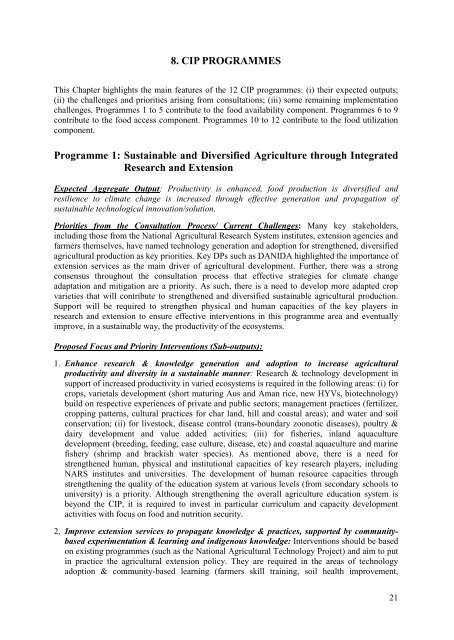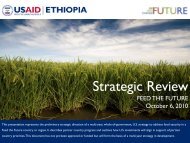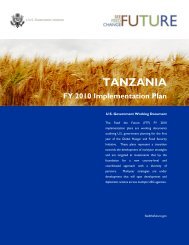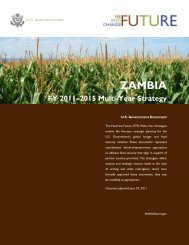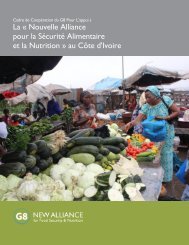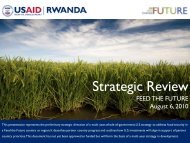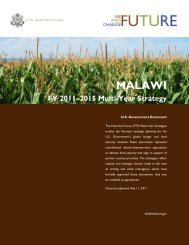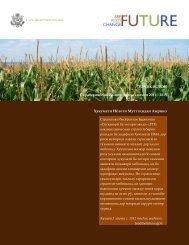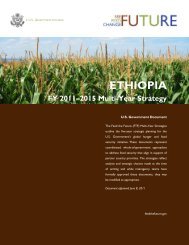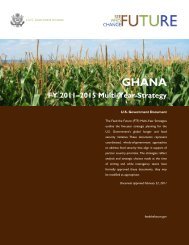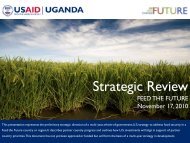Bangladesh Country Investment Plan - Feed the Future
Bangladesh Country Investment Plan - Feed the Future
Bangladesh Country Investment Plan - Feed the Future
Create successful ePaper yourself
Turn your PDF publications into a flip-book with our unique Google optimized e-Paper software.
8. CIP PROGRAMMES<br />
This Chapter highlights <strong>the</strong> main features of <strong>the</strong> 12 CIP programmes: (i) <strong>the</strong>ir expected outputs;<br />
(ii) <strong>the</strong> challenges and priorities arising from consultations; (iii) some remaining implementation<br />
challenges. Programmes 1 to 5 contribute to <strong>the</strong> food availability component. Programmes 6 to 9<br />
contribute to <strong>the</strong> food access component. Programmes 10 to 12 contribute to <strong>the</strong> food utilization<br />
component.<br />
Programme 1: Sustainable and Diversified Agriculture through Integrated<br />
Research and Extension<br />
Expected Aggregate Output: Productivity is enhanced, food production is diversified and<br />
resilience to climate change is increased through effective generation and propagation of<br />
sustainable technological innovation/solution.<br />
Priorities from <strong>the</strong> Consultation Process/ Current Challenges: Many key stakeholders,<br />
including those from <strong>the</strong> National Agricultural Research System institutes, extension agencies and<br />
farmers <strong>the</strong>mselves, have named technology generation and adoption for streng<strong>the</strong>ned, diversified<br />
agricultural production as key priorities. Key DPs such as DANIDA highlighted <strong>the</strong> importance of<br />
extension services as <strong>the</strong> main driver of agricultural development. Fur<strong>the</strong>r, <strong>the</strong>re was a strong<br />
consensus throughout <strong>the</strong> consultation process that effective strategies for climate change<br />
adaptation and mitigation are a priority. As such, <strong>the</strong>re is a need to develop more adapted crop<br />
varieties that will contribute to streng<strong>the</strong>ned and diversified sustainable agricultural production.<br />
Support will be required to streng<strong>the</strong>n physical and human capacities of <strong>the</strong> key players in<br />
research and extension to ensure effective interventions in this programme area and eventually<br />
improve, in a sustainable way, <strong>the</strong> productivity of <strong>the</strong> ecosystems.<br />
Proposed Focus and Priority Interventions (Sub-outputs):<br />
1. Enhance research & knowledge generation and adoption to increase agricultural<br />
productivity and diversity in a sustainable manner: Research & technology development in<br />
support of increased productivity in varied ecosystems is required in <strong>the</strong> following areas: (i) for<br />
crops, varietals development (short maturing Aus and Aman rice, new HYVs, biotechnology)<br />
build on respective experiences of private and public sectors; management practices (fertilizer,<br />
cropping patterns, cultural practices for char land, hill and coastal areas); and water and soil<br />
conservation; (ii) for livestock, disease control ( trans-boundary zoonotic diseases), poultry &<br />
dairy development and value added activities; (iii) for fisheries, inland aquaculture<br />
development (breeding, feeding, case culture, disease, etc) and coastal aquaculture and marine<br />
fishery (shrimp and brackish water species) . As mentioned above, <strong>the</strong>re is a need for<br />
streng<strong>the</strong>ned human, physical and institutional capacities of key research players, including<br />
NARS institutes and universities. The development of human resource capacities through<br />
streng<strong>the</strong>ning <strong>the</strong> quality of <strong>the</strong> education system at various levels (from secondary schools to<br />
university) is a priority. Although streng<strong>the</strong>ning <strong>the</strong> overall agriculture education system is<br />
beyond <strong>the</strong> CIP, it is required to invest in particular curriculum and capacity development<br />
activities with focus on food and nutrition security.<br />
2. Improve extension services to propagate knowledge & practices, supported by communitybased<br />
experimentation & learning and indigenous knowledge: Interventions should be based<br />
on existing programmes (such as <strong>the</strong> National Agricultural Technology Project) and aim to put<br />
in practice <strong>the</strong> agricultural extension policy. They are required in <strong>the</strong> areas of technology<br />
adoption & community-based learning (farmers skill training, soil health improvement,<br />
21


